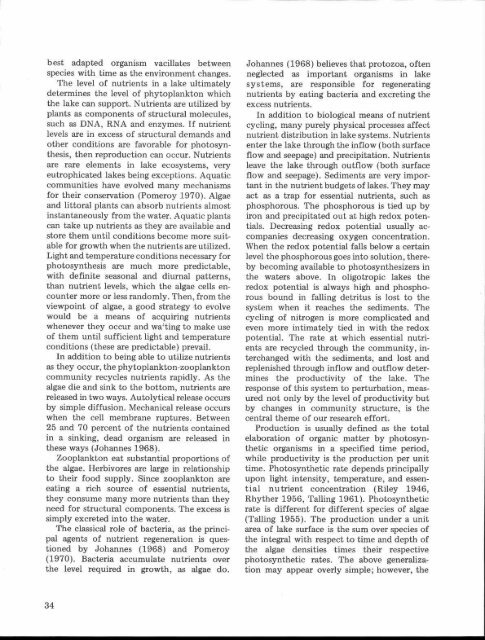PE EIE[R-Rg RESEARCH ON - HJ Andrews Experimental Forest
PE EIE[R-Rg RESEARCH ON - HJ Andrews Experimental Forest
PE EIE[R-Rg RESEARCH ON - HJ Andrews Experimental Forest
You also want an ePaper? Increase the reach of your titles
YUMPU automatically turns print PDFs into web optimized ePapers that Google loves.
est adapted organism vacillates betwee n<br />
species with time as the environment changes .<br />
The level of nutrients in a lake ultimatel y<br />
determines the level of phytoplankton whic h<br />
the lake can support . Nutrients are utilized b y<br />
plants as components of structural molecules ,<br />
such as DNA, RNA and enzymes . If nutrien t<br />
levels are in excess of structural demands an d<br />
other conditions are favorable for photosynthesis,<br />
then reproduction can occur . Nutrient s<br />
are rare elements in lake ecosystems, very<br />
eutrophicated lakes being exceptions . Aquati c<br />
communities have evolved many mechanisms<br />
fOr their conservation (Pomeroy 1970) . Algae<br />
and littoral plants can absorb nutrients almos t<br />
instantaneously from the water . Aquatic plants<br />
can take up nutrients as they are available and<br />
store them until conditions become more suit -<br />
able for growth when the nutrients are utilized .<br />
Light and temperature conditions necessary for<br />
photosynthesis are much more predictable ,<br />
with definite seasonal and diurnal patterns ,<br />
than nutrient levels, which the algae cells en -<br />
counter more or less randomly . Then, from the<br />
viewpoint of algae, a good strategy to evolve<br />
would be a means of acquiring nutrient s<br />
whenever they occur and wa iting to make use<br />
of them until sufficient light and temperature<br />
conditions (these are predictable) prevail .<br />
In addition to being able to utilize nutrient s<br />
as they occur, the phytoplankton-zooplankto n<br />
community recycles nutrients rapidly . As th e<br />
algae die and sink to the bottom, nutrients are<br />
released in two ways . Autolytical release occurs<br />
by simple diffusion. Mechanical release occurs<br />
when the cell membrane ruptures . Betwee n<br />
25 and 70 percent of the nutrients containe d<br />
in a sinking, dead organism are released i n<br />
these ways (Johannes 1968) .<br />
Zooplankton eat substantial proportions o f<br />
the algae . Herbivores are large in relationship<br />
to their food supply . Since zooplankton are<br />
eating a rich source of essential nutrients ,<br />
they consume many more nutrients than they<br />
need for structural components. The excess is<br />
simply excreted into the water .<br />
The classical role of bacteria, as the principal<br />
agents of nutrient regeneration is questioned<br />
by Johannes (1968) and Pomeroy<br />
(1970). Bacteria accumulate nutrients ove r<br />
the level required in growth, as algae do .<br />
Johannes (1968) believes that protozoa, ofte n<br />
neglected as important organisms in lak e<br />
systems, are responsible for regeneratin g<br />
nutrients by eating bacteria and excreting th e<br />
excess nutrients .<br />
In addition to biological means of nutrient<br />
cycling, many purely physical processes affec t<br />
nutrient distribution in lake systems . Nutrients<br />
enter the lake through the inflow (both surface<br />
flow and seepage) and precipitation . Nutrients<br />
leave the lake through outflow (both surface<br />
flow and seepage) . Sediments are very important<br />
in the nutrient budgets of lakes . They may<br />
act as a trap for essential nutrients, such a s<br />
phosphorous. The phosphorous is tied up b y<br />
iron and precipitated out at high redox potentials.<br />
Decreasing redox potential usually ac -<br />
companies decreasing oxygen concentration .<br />
When the redox potential falls below a certain<br />
level the phosphorous goes into solution, there -<br />
by becoming available to photosynthesizers i n<br />
the waters above . In oligotropic lakes th e<br />
redox potential is always high and phosphorous<br />
bound in falling detritus is lost to th e<br />
system when it reaches the sediments . Th e<br />
cycling of nitrogen is more complicated an d<br />
even more intimately tied in with the redo x<br />
potential . The rate at which essential nutrients<br />
are recycled through the community, interchanged<br />
with the sediments, and lost and<br />
replenished through inflow and outflow deter -<br />
mines the productivity of the lake . The<br />
response of this system to perturbation, measured<br />
not only by the level of productivity but<br />
by changes in community structure, is th e<br />
central theme of our research effort .<br />
Production is usually defined as the total<br />
elaboration of organic matter by photosynthetic<br />
organisms in a specified time period ,<br />
while productivity is the production per unit<br />
time. Photosynthetic rate depends principall y<br />
upon light intensity, temperature, and essential<br />
nutrient concentration (Riley 1946 ,<br />
Rhyther 1956, Tailing 1961) . Photosynthetic<br />
rate is different for different species of alga e<br />
(Talling 1955) . The production under a uni t<br />
area of lake surface is the sum over species o f<br />
the integral with respect to time and depth o f<br />
the algae densities times their respectiv e<br />
photosynthetic rates . The above generalization<br />
may appear overly simple ; however, the<br />
34








